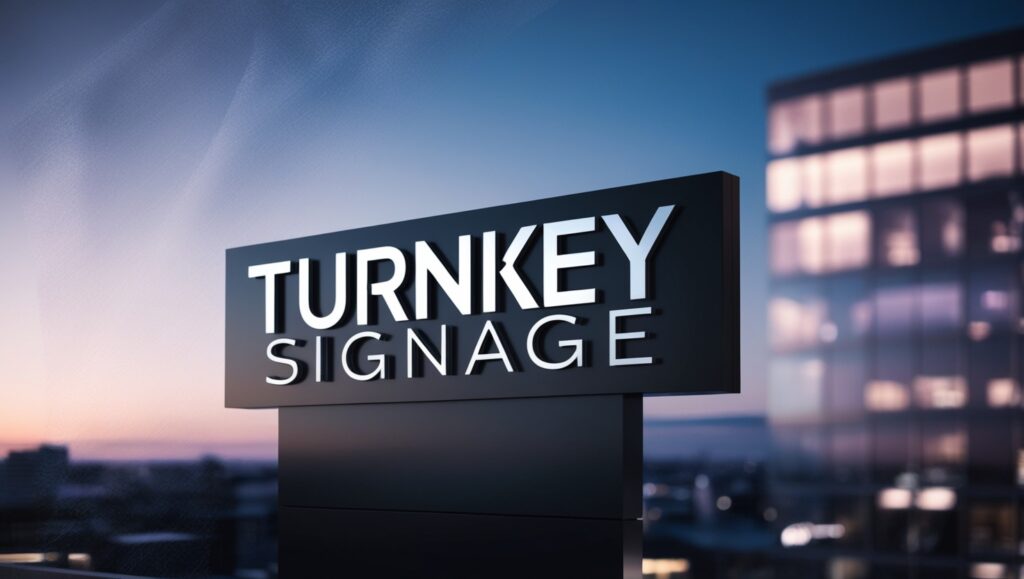In today’s world, businesses are constantly looking for ways to improve their visibility and communication with customers. One of the most effective methods of achieving this is through the use of signage. Whether it’s for retail stores, offices, airports, or public spaces, signage serves as a powerful tool for advertising, directions, and information sharing. Among the various types of signage solutions, Turnkey Signage has become a popular choice for companies looking for a comprehensive, hassle-free approach to their signage needs. A Turnkey Signage solution refers to a fully integrated service that covers everything from design to installation, offering businesses a one-stop-shop for all their signage requirements.
The concept of Turnkey Signage revolves around providing a complete, end-to-end service. From the initial idea to the final installation, a turnkey provider manages every aspect of the signage process. This includes the design, fabrication, materials selection, and installation of signage boards. By opting for a Turnkey Signage solution, businesses can streamline their efforts, saving time and resources, while ensuring that the signage they use is consistent, high-quality, and effective.
Key Components of a Turnkey Signage Solution
A Turnkey Signage project involves several steps that ensure the final result is both functional and aesthetically pleasing. Here are the key components that make up a typical turnkey signage solution:
Consultation and Planning
The first step in any Turnkey Signage project is consultation and planning. The client discusses their needs with the signage provider, detailing the purpose of the signage, the target audience, and the locations where the signs will be installed. At this stage, the type of signage is decided, whether it’s a signage board, digital signage, or an interactive display. Planning is essential for identifying the best materials, designs, and methods to ensure the signage serves its purpose effectively.
Design and Customization
Once the planning phase is complete, the design process begins. A team of graphic designers and signage specialists works together to create a custom design that aligns with the client’s branding and objectives. The design process often includes creating mockups and prototypes to visualize how the final signage will look in its intended location. Customization is a vital aspect of the Turnkey Signage solution, as it ensures that the signage stands out and effectively communicates the desired message.
Fabrication
After the design is finalized, the next step is fabrication. The fabrication process involves creating the actual signage, whether it’s a signage board, digital screen, or another form of display. Materials like acrylic, aluminum, vinyl, and LED components are commonly used depending on the type of signage. The quality of the materials is crucial to ensuring the signage is durable, weather-resistant, and long-lasting.
Signage Installation
Once the signage is fabricated, the installation phase begins. Signage installation can be a complex process, especially when dealing with large or digital signage boards. The installation team ensures that the signage is mounted securely, is positioned correctly, and complies with all safety standards and regulations. In many cases, the installation is done after business hours to minimize disruption to the daily operations of the business. The final result should be a functional and eye-catching signage display that meets the client’s specifications.
Ongoing Maintenance
A key benefit of a Turnkey Signage solution is that many providers offer ongoing maintenance and support. Regular maintenance ensures that the signage remains in optimal condition and continues to function as intended. This is especially important for digital signage, which may require updates, software maintenance, and occasional repairs. Ongoing maintenance can also include cleaning and touch-ups for physical signage boards to maintain their appearance over time.
Types of Turnkey Signage Solutions
There are many different types of signage solutions available to businesses today. A Turnkey Signage solution is not limited to one type but can include a variety of signage options, each suited to different needs and environments. Some of the most common types include:
Traditional Signage Boards
Traditional signage boards remain a staple in the world of advertising and direction. These can be made from various materials such as wood, metal, plastic, or acrylic, and can be used for everything from storefronts to directional signs within a building. Signage boards are versatile and cost-effective, making them an ideal choice for businesses looking for a simple yet impactful way to communicate with customers.
Digital Signage
Digital signage is becoming more popular due to its ability to display dynamic content. Digital screens can show videos, advertisements, promotions, and real-time updates, making them ideal for high-traffic areas such as airports, malls, or public transport stations. With digital signage, businesses can easily update content remotely, allowing for flexibility and real-time communication.
Wayfinding Signage
People navigate large spaces such as hospitals, airports, shopping centers, and campuses with the help of wayfinding signage. This type of signage includes arrows, maps, and directional signs that guide people to their destinations. A Turnkey Signage solution for wayfinding typically involves custom designs and installations that are easy to follow and highly visible.
Interactive Signage
Interactive signage incorporates touch-screen technology, allowing users to interact directly with the signage. In these places: malls, museums, airports, and corporate offices, signs provide extra information or services. Businesses can customize interactive displays to show maps, directories, product catalogs, or promotions according to their specific needs.
The Benefits of Turnkey Signage Solutions
There are several benefits to choosing a Turnkey Signage solution for your business:
Streamlined Process
With a turnkey approach, businesses do not have to coordinate with multiple vendors. One provider manages the entire process, ensuring that all aspects of the project come together seamlessly. This reduces the chances of miscommunication and delays, making the process much smoother.
Customization
A Turnkey Signage solution allows businesses to tailor the signage to their specific needs. Whether it’s a unique design, custom materials, or a specialized installation process, turnkey providers can create signage that perfectly fits the business’s goals.
Cost-Effective
By bundling all aspects of the signage project into one package, businesses can often save money. Turnkey providers can offer competitive pricing and may be able to source materials and services at a lower cost due to their established relationships with suppliers and contractors.
Expertise
Turnkey signage providers bring expertise in design, fabrication, and installation. Their knowledge and experience ensure that businesses receive high-quality signage that meets their standards and regulations. The provider can handle any challenges that arise during the project, ensuring that the final product is both functional and aesthetically pleasing.
Ongoing Support
Many Turnkey Signage solutions offer ongoing support, including maintenance, repairs, and updates. This is particularly important for digital signage, which requires regular updates and monitoring to ensure it operates smoothly.
Choosing a Signage Board Maker
Selecting the right signage board maker is critical for the success of your signage project. When evaluating potential signage providers, consider the following factors:
- Experience: Look for a signage board maker with experience in your industry or with similar types of signage.
- Portfolio: Review the provider’s past projects to gauge the quality of their work.
- Customization Options: Ensure the provider can offer a high level of customization to meet your needs.
- Installation and Maintenance: Check if the provider offers installation services and ongoing support for the signage.
Choosing the right signage provider ensures that your signage board will not only look great but will also serve its purpose effectively over time.
Summary
In summary, Turnkey Signage solutions provide businesses with a comprehensive approach to their signage needs, covering everything from design to installation and maintenance. Whether it’s a traditional signage board or advanced digital signage, turnkey providers offer expertise and efficiency in delivering high-quality solutions. During the signage installation process, we position the final product perfectly to maximize visibility and communication. By choosing a reliable signage board maker, businesses can achieve effective branding and communication with minimal hassle. With the right signage, companies can make a lasting impact on their audience and improve their overall visibility in today’s competitive market.


